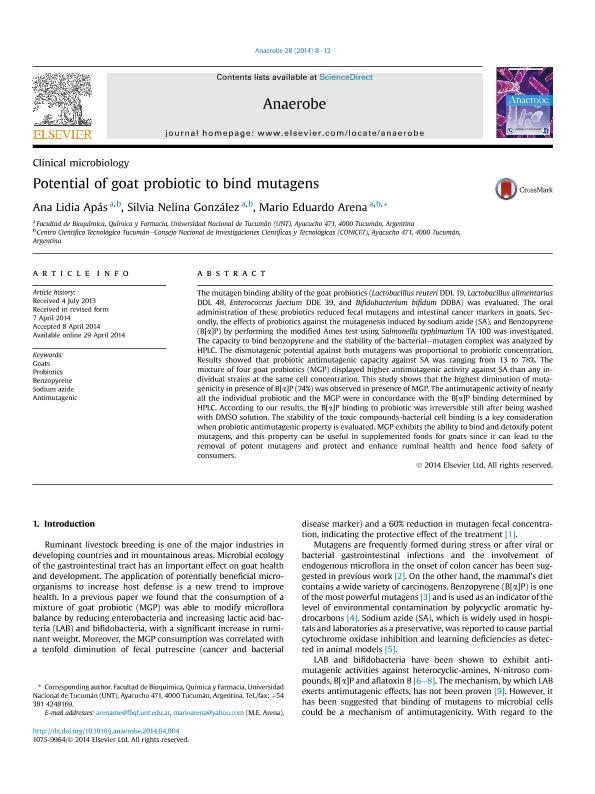Mostrar el registro sencillo del ítem
dc.contributor.author
Apas, Ana Lidia

dc.contributor.author
Gonzalez, Silvia Nelina

dc.contributor.author
Arena, Mario Eduardo

dc.date.available
2017-12-28T17:56:44Z
dc.date.issued
2014-04
dc.identifier.citation
Apas, Ana Lidia; Gonzalez, Silvia Nelina; Arena, Mario Eduardo; Potential of goat probiotic to bind mutagens; Elsevier; Anaerobe; 28; 4-2014; 8-12
dc.identifier.issn
1075-9964
dc.identifier.uri
http://hdl.handle.net/11336/31838
dc.description.abstract
The mutagen binding ability of the goat probiotics (Lactobacillus reuteri DDL 19, Lactobacillus alimentarius DDL 48, Enterococcus faecium DDE 39, and Bifidobacterium bifidum DDBA) was evaluated. The oral administration of these probiotics reduced fecal mutagens and intestinal cancer markers in goats. Secondly, the effects of probiotics against the mutagenesis induced by sodium azide (SA), and Benzopyrene (B[α]P) by performing the modified Ames test using Salmonella typhimurium TA 100 was investigated. The capacity to bind benzopyrene and the stability of the bacterial–mutagen complex was analyzed by HPLC. The dismutagenic potential against both mutagens was proportional to probiotic concentration. Results showed that probiotic antimutagenic capacity against SA was ranging from 13 to 78%. The mixture of four goat probiotics (MGP) displayed higher antimutagenic activity against SA than any individual strains at the same cell concentration. This study shows that the highest diminution of mutagenicity in presence of B[α]P (74%) was observed in presence of MGP. The antimutagenic activity of nearly all the individual probiotic and the MGP were in concordance with the B[α]P binding determined by HPLC. According to our results, the B[α]P binding to probiotic was irreversible still after being washed with DMSO solution. The stability of the toxic compounds-bacterial cell binding is a key consideration when probiotic antimutagenic property is evaluated. MGP exhibits the ability to bind and detoxify potent mutagens, and this property can be useful in supplemented foods for goats since it can lead to the removal of potent mutagens and protect and enhance ruminal health and hence food safety of consumers.
dc.format
application/pdf
dc.language.iso
eng
dc.publisher
Elsevier

dc.rights
info:eu-repo/semantics/openAccess
dc.rights.uri
https://creativecommons.org/licenses/by-nc-nd/2.5/ar/
dc.subject
Goats
dc.subject
Probiotic
dc.subject
Benzopyrene
dc.subject
Sodium Azide
dc.subject
Antimutagenic
dc.subject.classification
Otras Biotecnologías de la Salud

dc.subject.classification
Biotecnología de la Salud

dc.subject.classification
CIENCIAS MÉDICAS Y DE LA SALUD

dc.title
Potential of goat probiotic to bind mutagens
dc.type
info:eu-repo/semantics/article
dc.type
info:ar-repo/semantics/artículo
dc.type
info:eu-repo/semantics/publishedVersion
dc.date.updated
2017-12-27T15:20:46Z
dc.journal.volume
28
dc.journal.pagination
8-12
dc.journal.pais
Países Bajos

dc.journal.ciudad
Amsterdam
dc.description.fil
Fil: Apas, Ana Lidia. Universidad Nacional de Tucumán. Facultad de Bioquímica, Química y Farmacia; Argentina. Consejo Nacional de Investigaciones Científicas y Técnicas. Centro Científico Tecnológico Conicet - Tucuman; Argentina
dc.description.fil
Fil: Gonzalez, Silvia Nelina. Universidad Nacional de Tucumán. Facultad de Bioquímica, Química y Farmacia; Argentina. Consejo Nacional de Investigaciones Científicas y Técnicas. Centro Científico Tecnológico Conicet - Tucuman; Argentina
dc.description.fil
Fil: Arena, Mario Eduardo. Universidad Nacional de Tucumán. Facultad de Bioquímica, Química y Farmacia; Argentina. Consejo Nacional de Investigaciones Científicas y Técnicas. Centro Científico Tecnológico Conicet - Tucuman; Argentina
dc.journal.title
Anaerobe

dc.relation.alternativeid
info:eu-repo/semantics/altIdentifier/doi/http://dx.doi.org/10.1016/j.anaerobe.2014.04.004
dc.relation.alternativeid
info:eu-repo/semantics/altIdentifier/url/http://www.sciencedirect.com/science/article/pii/S1075996414000365
Archivos asociados
